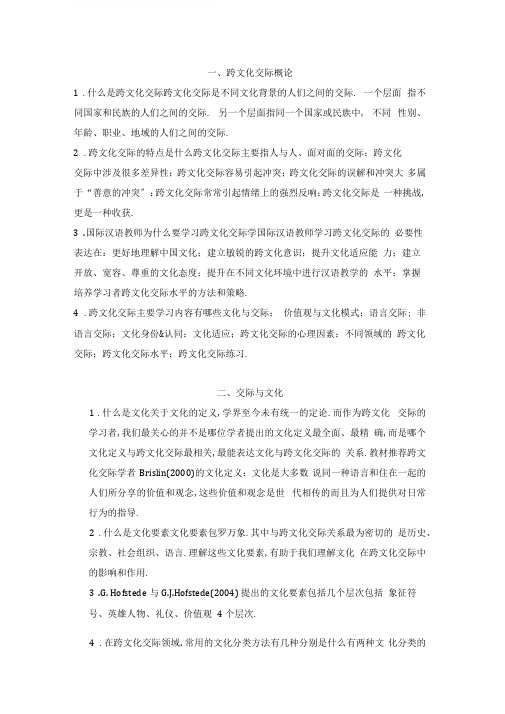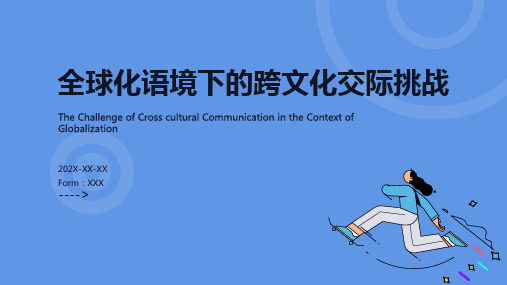跨文化交际Ch03
跨文化交际第三章

跨文化交际第三章Chapter 3 :Culture and CommunicationDefinitions of cultureThe functions of cultureThe Characteristics of cultureThe relationship between culture and communicationElements of intercultural communicationCulture is Our Invisible TeacherCulture is everything and everywhere, culture and communication work in tandem 一个跟着一个地. In fact ,they are inseparable: it is often difficult to decide which is the voice and which the echo.Functions of cultureThe world is a confusing place until we can make some sense of it, so the basic function of culture is to explain the world to each new member of the culture. By telling us what to expect, culture reduces confusion and helps us predict the future.Culture is shared learned behavior that is transmitted from one generation to another for purposes of promoting individual and social survival, adaptation, and growth and development.Definition of cultureWe define culture as the deposit of knowledge ,experience, beliefs, values, attitudes, meanings, hierarchies, religion, notions of time, roles, spatial relations, concepts of the universe, and material objects and possessionacquired by a group of people in the course of generations through individual and group striving.The Characteristics of Culture 6Culture is not Innate; it is learnedCulture is transmitted from generation to generationCulture is based on symbolsCulture is integratedCulture is subject to changeCulture is ethnocentricWe learn our culture through proverbs. We learn our culture from folk tales, legends , and myths. We learn our culture through art. We learn our culture through mass media.We learn our culture in many different ways consciously and unconsciously.We also learn our culture from folk tales and folklore. Whether it embodies ancient myths or current popular beliefs, folklore is value-laden and teaches and reinforces what a culture deems important.In a word, many of the behaviors we label as cultural are not only automatic and invisible, but also engaged in without our being aware of them.Culture is ethnocentricCulture is Ethnocentric, one own group is the center of everything, andall others are scaled and rated with reference to it. It is found in every culture. It can have positive effects, it is a source of cultural and personal identity. It takes on a negative condition when provide the base for derogatory evaluation and rebuff change.What’s the relationship between culture and communicationLanguage and culture are inextricably linked so that learning language means learning culture and vice versa.It is obvious that a language learner has more to do than master a new grammarand vocabulary.The relationship between culture and communicationCulture and communication mutually influences one another, producing different behavior patterns in different contexts. Culture not only conditions our perception of reality but also programmes our language pattern. what, where and how we should talk are regulated by our culture.culture shapes our communication patterns but communication influences the structure of our culture. So culture and communication are inseparable. In order to study inter-culture communication we must and explore their relationships.Elements of Intercultural Communication1.perception2.verbal processes3.nonverbal processesPerception: is an internal process whereby we convert the physical energies of the world into meaningful internal experiences.(1) People behave as they do because of the ways in which theyperceive the world.(2)One learns these perceptions, and the behaviors they produce, as part of one’s cultural experiences.The stages of perception process1.selection:it is the main part of converting the external stimuli into meaningful experiences.2.Category: arrange the information3.interpretation:try to assign meaning to what you perceive.Culture strong impact on the perception culture not only provide the foundation for the meaning we give to ourperception, it also direct us to specific kinds of messages and event.。
跨文化交际PPT演示课件

3. Space and Distance
3.1 Proxemics 3.2 Attitudes Toward Crowding
24
3.1 Proxemics
✓ Definition: the study of people’s perception and use of space.
✓ Four categories: intimate, personal, social, and public distance.
26
Categories of Distance (cont’d)
• Social Distance (1.3-3m) - colleagues, business partners, people at social gatherings
• Public Distance (beyond 3m) - speaking in public
- direct intrusion into others’ affairs • Shrugging shoulders
- indifferent, powerless, having no secret to conceal
19
Postures (cont’d)
• Follow one’s natural habits so often go unnoticed (subconscious in nature)
• May damage your image if you neglect your postures
20
2.4 Eye Contact
Direct eye contact • Chinese: avoid • North Americans: appreciate • The British: avoid
跨文化交际第三章ppt

Dominant American Cultural Patterns
Individualism
by John Locke
Each individual is unique,
special, completely different
from others.
Equality
All people has the right to succeed
Proverbs (explanation) • Blood is thicker than water. Value: family, loyalty Origin: Scotland • The early bird catches the worm. Value: action Origin: England • God helps those who help themselves. Value: self-help Origin: Greece • Haste makes waste. Value: patience Origin: England • Time is money. Value: efficiency Origin: USA • Think three times before you take action. Value: caution Origin: China
organization interpretation
Second
Selection/stimulation
Understanding Perception
Cultural Filters & Perceptions
information and impressions from reality
跨文化交际知识点汇总

一、跨文化交际概论1.什么是跨文化交际跨文化交际是不同文化背景的人们之间的交际. 一个层面指不同国家和民族的人们之间的交际. 另一个层面指同一个国家或民族中, 不同性别、年龄、职业、地域的人们之间的交际.2.跨文化交际的特点是什么跨文化交际主要指人与人、面对面的交际;跨文化交际中涉及很多差异性;跨文化交际容易引起冲突;跨文化交际的误解和冲突大多属于“善意的冲突〞;跨文化交际常常引起情绪上的强烈反响;跨文化交际是一种挑战,更是一种收获.3.国际汉语教师为什么要学习跨文化交际学国际汉语教师学习跨文化交际的必要性表达在:更好地理解中国文化;建立敏锐的跨文化意识;提升文化适应能力;建立开放、宽容、尊重的文化态度;提升在不同文化环境中进行汉语教学的水平;掌握培养学习者跨文化交际水平的方法和策略.4.跨文化交际主要学习内容有哪些文化与交际;价值观与文化模式;语言交际; 非语言交际;文化身份&认同;文化适应;跨文化交际的心理因素;不同领域的跨文化交际;跨文化交际水平;跨文化交际练习.二、交际与文化1.什么是文化关于文化的定义,学界至今未有统一的定论.而作为跨文化交际的学习者,我们最关心的并不是哪位学者提出的文化定义最全面、最精确,而是哪个文化定义与跨文化交际最相关,最能表达文化与跨文化交际的关系.教材推荐跨文化交际学者Brislin(2000)的文化定义:文化是大多数说同一种语言和住在一起的人们所分享的价值和观念,这些价值和观念是世代相传的而且为人们提供对日常行为的指导.2.什么是文化要素文化要素包罗万象.其中与跨文化交际关系最为密切的是历史、宗教、社会组织、语言.理解这些文化要素,有助于我们理解文化在跨文化交际中的影响和作用.3.G. Hofstede与G.J.Hofstede(2004) 提出的文化要素包括几个层次包括象征符号、英雄人物、礼仪、价值观4个层次.4.在跨文化交际领域,常用的文化分类方法有几种分别是什么有两种文化分类的方法在跨文化交际领域最为常用.一种是客观文化与主观文化.另二种是主导文化与亚文化.5.文化有什么特点呢〔1〕文化是后天习得的.〔2〕文化是共享的,并世代相传.〔3〕大局部文化是无意识的.〔4〕文化是象征的.〔5〕文化是动态的.6.什么是交际与文化的定义相似,关于交际的定义也非常丰富和复杂.教材仅推荐与跨文化交际语用领域相关的定义.即Gudykunst& Kim〔2003〕提出的关于交际的定义:交际是编码和解码的过程,但是这种编码和解码的过程并非单纯的传递和接受过程,而是包含着意义的协商和共建.7.交际的要素是什么交际是互相交往的过程,交际的全部过程包含以下要素:传送者、信息、编码、解码、媒介、反响、噪音.8.交际有什么特点〔1〕交际是象征的〔2〕交际是动态的过程〔3〕交际涉及意义的协商和共建〔4〕交际发生在意识的各个层面.〔5〕交际是特定语境中发生的.9.文化对交际有什么影响文化从两个层面影响交际:一是从文化标准的层面,二是从个人层面.文化影响着人们的感知.首先, 文化影响人们对外部刺激的选择.其次,文化影响人们对外部刺激的分类.第三,文化影响人们对外部刺激的意义联想.最后,文化影响人们对外部刺激的解释.文化的特征值是它为行为提供指南.文化影响人们的饮食行为.文化还影响人们的衣着打扮.文化影响居住方式.文化影响人们的出行方式.文化也影响了人与人交往的方式.1.什么是价值观价值观不是实际的行为, 而是关于行为的规那么;价值观是一套关于什么是真善美的标准系统;这些规那么和标准是用来判断和指导人们的行为的;价值观不是个人的爱好或倾向,而是一种集体的文化意识.2.价值观如何分类一类是终极性价值观, 它是关于生命、生存等终极目标的价值观,另一类是工具性价值观,它是关于道德和水平的价值观.3.价值观有什么特点〔1〕价值观属于深层文化.〔2〕价值观是人们的行为指南. 〔3〕价值观既是稳定的,也是变化的.〔4〕不同文化的价值观既有相同的也有不同的成分.〔5〕价值观被违背时会引起情感上的强烈反响.4.关于价值观模式的研究具有影响力的理论是哪些1.价值取向理论〔由kluckhohn与Strodtbeck提出〕2.文化尺度〔由Hofstede提出〕3.高语境文化与低语境文化〔由Hall提出〕.5.中国文化模式有什么特点〔 1〕集体主义〔2〕以家庭为中央〔3〕尊重传统〔4〕等级观念〔5〕面子观念〔6〕重视人情6.美国文化模式有什么特点〔 1〕个体主义〔2〕平等观念〔3〕强调变化和进步〔4〕物质享受〔5〕科学与技术〔6〕工作与娱乐〔7〕竞争意识四、跨文化的语言交际1概念提要:1.萨丕尔-沃尔夫假说的含义萨丕尔-沃尔有三层含义.〔1〕不同的语言以不同的方式感知和划分世界.〔2〕一个人所使用的语言结构影响他感知和理解世界的方式.〔3〕讲不同语言的人感知世界是不同的.2.语言与价值观之间是什么关系语言与文化的关系最直接的表达是语言表达了人们对世界的看法、态度和价值取向.每种语言都拥有丰富的格言、警句和俗语.这些句子往往就是价值观的表达.3.词义与文化是什么关系在语言的各要素中,词汇与文化的关系最为密切,其对跨文化交际的影响也最为突出.语言的含义不具有普遍性,它受到文化和语境的制约.不同语言和文化的人们进行跨文化交际时,可能会由于对词语含义的误解而产生交流的障碍.4.什么叫委婉语学习它有什么意义禁忌是人类社会普遍存在的文化现象, 人们对诸如生老病死、隐私等许多方面多有避讳,因此产生了大量的委婉语. 了解不同文化中的禁忌和相应的委婉语不仅可以深入理解不同文化的价值取向,也可以防止在跨文化交际中出现不必要的误会.四、跨文化的语言交际2概念提要:1.礼貌原那么包括哪些准那么〔1〕得体准那么〔2〕慷慨准那么〔3〕赞扬准那么〔4〕谦虚准那么〔5〕一致准那么〔6〕同情准那么.2.中国人的礼貌特征包括哪些〔1〕贬己尊人〔2〕称呼准那么〔3〕文雅准那么〔4〕求同准那么〔5〕德、言、行准那么.3.礼貌策略的使用受到什么因素的制约〔1〕说话人与听话人之间的权力距离〔2〕说话人与听话人之间的社会距离〔3〕言语行为的强加程度4.什么是交际风格交际风格是指说话的特点.5.在跨文化交际领域中,常见的交际风格包括哪些〔1〕直接与间接的交际风格〔2〕谦虚与自信的交际风格〔3〕归纳与演绎的交际风格五、跨文化的非语言交际概念提要:1.什么是非言语交际非言语交际不包括语言,而是包括了各种非语言的交际行为;非语言交际具有互动性,涉及信息的发出者和接受者的编码和解码过程;非言语交际是在特定情境中产生的,与语境有密切关系;非语言交际可能是有意的,也可能是无意的.2.非语言交际的功能有哪些〔 1〕传达真实的内在感情〔2〕营造交际印象〔3〕进行会话治理3.非语言交际与语言交际是什么关系非语言交际对语言信息起着重复、补充、代替、标准和否认等作用.4.体态语包括哪些人们的外貌服饰、面部表情、眼神交流、手势、姿势以及身体接触都是体态语,都参与了交际,是非语言交际的一局部.5.时间观念与文化之间有什么联系时间观念是非语言交际的重要维度, 也是价值观的表达.6.什么是单时制文化其特点是什么单时制文化中的时间是线性的,可以向前延伸到未来,向后延伸到过去.单时制文化的人们通过方案和预约来限制时间,在一段时间内只做一件事,强调准时、预约和最后期限.7.什么是多时制文化其特点是什么多时制文化并不把时间看做是线性的.多时制文化中的人认为时间围绕着生活,在同一时间内可以做多件事情.工作常常被打断,方案也常改变.身处多时制文化中的人,维系人际关系和谐远比遵守时间重要.8.人们对于空间的利用与文化之间有什么联系空间利用也是非语言交际的重要内容.空间利用方式表达了特定文化中人际关系的特点.六、文化适应概念提要:1.文化适应策略有哪些同化、别离、融合以及边缘化.2.文化适应是一个复杂、动态的开展过程.短期旅居者的跨文化适应过程分为哪几个阶段蜜月期、挫折期、恢复期和适应期.3.焦虑处理理论认为什么因素影响跨文化适应个体性格因素、社会支持、性别、民族、处理文化适问题的策略等.4.什么是文化休克文化休克是一种因失去了熟悉的社会交往符号而产生的心理焦虑.5.应对文化休克可采取什么策略应对呢广交朋友,建立良好人际关系;学习目的国的语言;了解目的文化的知识;做自己感兴趣的事情;参加社会文化活动;改变自己的思维.6.什么是文化适应假说第二语言教学领域的学者很早注意到了文化适应与第二语言学习的关系.Schuman(1986跟出了文化适应假说〞.他认为, 学习者只有适应了第二文化以后才能习得第二语言,文化适应的程度决定第二语言学习的程度.7.Schuman(198觎出的社会距离的概念是什么社会距离指的是学习者的原有文化与目的语文化之间的差异程度.七、跨文化的人际交往概念提要:1.人际关系与文化的联系表达在哪几方面不同文化间的朋友关系、人情关系、工作关系、与陌生人之间的关系都受到文化的影响.2.交往习俗与文化之间有什么联系在社会交往中,人们需要遵循社交礼仪和规那么,而这些规那么会因文化而异.一种文化中得体、礼貌的规那么到了另一种文化中可能是不得体的,甚至还造成了冒犯.了解不同文化的社交习俗和礼仪,对提升跨文化交际的有效性和得体性是非常有必要的.3.公共礼仪与文化之间有什么联系遵守公共秩序和礼仪是现代人的基本素养,也是一个国家文明程度的表达. 在跨文化交往中,了解和遵守不同文化的公共礼仪非常重要.不遵守公共礼仪会给人留下负面的印象,甚至引起跨文化交往中的冲突.八、跨文化人际交际的心理与态度概念提要:1.什么是刻板印象刻板印象又作成见〞与谊型观念〞,是指一个群体成员特征的概括性看法.2.刻板印象有什么特点〔1〕刻板印象是人们正常思维的一局部.〔2〕刻板印象是文化的一局部.〔3〕刻板印象的最大局限是以偏概全,无视个体差异.3.如何克服刻板印象〔1〕意识到刻板印象的存在.〔2〕改变懒惰和简化的思维习惯.〔3〕扩大与不同文化的人的接触范围.〔4〕试图寻找充分的证据和例外的情况.〔5〕对于来自其他文化的个人的行为的描述,应采用表达性语言,而不是对这一文化群体进行评价和简单概括.4.什么是偏见偏见是对一个群体的成员建立在错误而僵化的概括根底上的负面感情5.如何克服偏见〔1〕坦诚面对自己的偏见.〔2〕扩大与不同文化的人的接触范围.〔3〕参加课程学习和培训.〔4〕在交际中防止使用带有偏见或歧视色彩的表达方式,特别是对弱势群体要注意使用委婉而礼貌的称呼.6.什么是种族中央种族中央指的是在思考和评价别的文化时,把自己的文化放在一切事物的中央位置,并且以自己文化的框架作为衡量的标准.7.什么是文化相对主义文化相对主义是与种族中央主义相对的概念.它最早由美国著名人类学家弗朗兹博厄斯所倡导.其包括两个方面的内容.第一, 每种文化都有自己长期形成的独特历史, 其形态并无上下之分;第二,任何一个民族都有自己的社会思想、世界观和道德观,人们不应该用自己的一套标准来衡量其它民族的文化.。
跨文化交际课件 第三次课

When does communication happen?
Critical Distance: p148 Situation: depends on context Communicating distance: depends on contact
Human Language
1. verbal: English, Chinese ; 2. nonverbal: non-word sounds ---
sounds uttered to control animals ; 3. body language ----- gestures, head
Meanings in communication
The author of the course book divides an utterance of words into three kinds of meanings: 1. Utterance Meaning is what an utterance normally means. 2. Speaker's meaning is what the speaker has intended to convey by way of utterance meaning. 3. Hearer's meaning is what the hearer has understood on the basis of the utterance meaning.
2.All human communication takes place in social situations.
3.Being polite is often considered a very important strategy in cross-cultural communication. However, polite expression in Chinese does not mean that it is also polite in English. Similarly a polite expression in English does not mean that it is equally polite in Chinese.
跨文化交际第三章课件

跨⽂化交际第三章课件Unit 3Daily Communication (II)Case AnalysisCompliments and Compliment Responses Gift-giving and gift-receiving ExercisesCase AnalysisAn Invitation to DinnerThe Cancellation of the Dinner Party Why should they do like this The Embarrassment Caused by “No Etiquette”Compliments and Compliment ResponsesMain point: Chinese modestySocial functions of compliments Differences between Chinese compliments and English complimentsCultural assumptionExpressions for gratitude in English and ChineseCommon expressions for apology inChinese ModestyOh, it’s an ordinary dress I bought in China.Should I blush, or should I tell him you don’t really mean it Growing flowers is my hobby, but I’m not much good at it.I really know so little about the subject....Social functions of complimentsCreating or reinforcing solidarity greeting peopleexpressing thankscongratulationencouraging peoplesoftening criticismstarting a conversationgetting over embarrassmentDifferences between Chinese compliments and English complimentsThe Semantic formulaThe Syntactic FormulaCommon responses formula in E-and C-complimentsThe Semantic FormulaEnglish:This was a great meal.Bill, you look so nice today.I love your dresses.About 80% adj. 16%verbs Chinese:你的房间不错。
跨文化交际3PPT课件

Low-context
Pity Relational
Uncertainty Avoidance
Power distance
Masculinity– Femininity
.
Chapter3 The Hidden Core of Culture
Lead-in Activity:
2. describe the components of cultural patterns.
2
3. summarize the theory about cultural patterns.
•4. evaluate the importance of cultural patterns.
3
.
.
Chapter3 The Hidden Core of Culture
The Characteristics of Values
• What’s the values reflected in the following proverbs?
• 1. Blood is thicker than water. • 2. Too many cooks spoil the broth(鱼汤). • 3. God helps those who help themselves. • 4. Time is money. • 5. A man’s home is his castle. • 6. Think three times before you take action. • 7. Nothing done with intelligence is done without speech.
• (富有智慧的无所作为是无言的作为).(沉默是金)
跨文化交际Unit3课件

Low-Context Communication or Message
Most of the information is given in the explicit code;
The context or situation plays a minimal role;
110-115)
Kluckhohn & Strodtbeck’s Model
Five basic orientations:
பைடு நூலகம்uman nature: good / evil?
Relationship of man to nature: Man subjugated by nature; Man in harmony with nature; Man the master of nature
Some Tools for Comparing and Contrasting Cultures
Kluckhohn & Strodtbeck’s Model (PP. 85-89) Hofstede’s Model (PP. 99-105) Hall’s High-Context & Low-Context Cultures (PP.
Dealing with interpersonal problems: confrontational strategies
Collectivism
Group: the most important social units Group-oriented, requiring an absolute loyalty to the group Obligations to the group, dependence of the individual on
跨文化交际(精品课件)

A Monumental Figure
• Edward Twitchell Hall, (1914 –2009) , American anthropologist and cross-cultural researcher.
• Hall introduced a number of new concepts, including proxemics, polychronigh and low context cultures.
Cross-cultural communication refers to any communication between two members of any cultural communities. (Samovar and Porter, 2004:47)
11
Cross-cultural Communication Vs
his Linguistic Across Cultures(《跨文化语言学》). He discussed the cultural comparison in three aspects: form, meaning and distribution(顾嘉祖,4). • In 1959,the Silent Language by Edward T. Hall initiated the cross-cultural studies. • R.Oliver , 1962, Culture and communication • A.G.Smith, 1966,Culture and communication • In 1970s, ICA (International Communication Association) accepted Cross-cultural Communication as a branch discipline. as a discipline) • Journals: International and Intercultural Journal of Intercultural Relations.
跨文化交际课件第二章文化与跨文化交际

尊重他人文化,学习对方语言,积极沟通交流,接受文化差异。
3 跨文化交际的重要性和价值
跨文化交际有助于促进文化交流、增进理解和合作,推动全球化进程。
跨文化交际课件文化的定义和成分、以及文化多样性的重要性。 还将探讨跨文化交际所面临的挑战以及应对策略。
理解文化
文化的定义
文化是一个社会共同的、长期形成的行为和信仰模式的集合。
文化的成分
文化包括语言、价值观、习俗、艺术、宗教等各个方面。
文化的多样性
各个社会和群体都有独特的文化特点和传统。
尊重对方文化
尊重他人的文化背景 和习俗,避免对其进 行评判或歧视。
学习对方语言
学习对方的语言有助 于加深沟通和理解, 建立更好的关系。
积极沟通交流
主动表达意见和需求, 倾听和理解对方的观 点,促进双向沟通。
接受文化差异
认识到不同文化之间 的差异,并以包容和 开放的态度对待。
例子分析
西方与中国商务谈判
跨文化交际的挑战
1 偏见与刻板印象
2 语言沟通障碍
人们可能根据文化差异产生偏见和刻板印象, 影响沟通。
不同的语言和表达方式可能导致误解和交流 困难。
3 礼仪与习惯的差异
不同地区的礼仪和习俗差异可能导致误解和 冲突。
4 文化冲突与文化霸权
不同文化之间的价值观和利益冲突可能引发 紧张局势。
跨文化交际的策略
分析西方和中国商务文化之间的差异,以及如何处理这些差异,提升谈判成功率。
西班牙与日本的餐桌礼仪
对比西班牙和日本的餐桌礼仪,展示不同文化之间的差异和重要性。
印度与美国的电话交流
探讨印度和美国在电话交流中可能遇到的文化差异和挑战,并提供有效的解决策略。
跨文化交际(全套课件266P)程胡超版

Westerners are being individualist, being equal and different. It is none of my business.
2012-2-16
15
6. People are racially different We are Hopo sapiens. Generally, the people in the world are classified into four major races, though not universally accepted. White/Caucasian; Mongoloid/Asian; Negroid/Black; Australoid/Brown
2012-2-16 4
Comment
What the interpreter said is quite
courteous in China. It means, ―If you are tired, we can take a little rest, since you are getting on in years.‖
2012-2-16
19
The Objectives
1) To explore cultural self-awareness, other culture awareness and the dynamics that arise in interactions between the two. 2) To understand how communication processes differ among cultures. 3) To identify challenges that arise from these differences in intercultural interactions and learn ways to creatively address them. 4) To acquire knowledge and develop skills that increase intercultural competence. 5) To have an understanding of the meaning of the cultures understood by the westerners and the easterners or the Chinese and Americans.
跨文化交际 课件

Chapter Three Verbal Communication1. Relationship between language and culture语言与文化有着密切的关系。
由于语言的产生和发展,人类文化才得以产生和传承。
不存在没有语言的文化,也不存在没有文化的语言。
广义的文化包括语言,同时文化又无时无刻不在影响语言,使语言为了适应文化发展变化的需要而变得更加精确和缜密。
文化影响语言的变化和发展,语言是文化的写照和反映。
有很多例证可以说明这一点:例证1:亲属称谓是语言反映文化的一个突出例证。
例如,在英语中的brother是“兄”或“弟”,sister是“姐”或“妹”,汉语中没有一个字与brother或sister完全对等。
在我们的文化中严格区分“兄”或“弟”、“姐”或“妹”,是因为“长幼有序”。
英语中的uncle一词相当于汉语中的“伯父、叔父、舅父、姨父、姑父”,aunt相当于汉语中的“伯母、婶母、舅母、姨母、姑母”。
这反映了汉族不仅注重长幼有序,而且对于是父系、母系或姻系也十分重视。
赵元任(Y. R. Chao)在《中国人的各种称谓》一文中列举了114种亲属称谓,每种又有正式称谓、直称及比较文气的称谓之分。
例如,父亲的祖父在汉语中的正式称谓是“曾祖”,直称时用“老爷爷”,书信中可能用“曾祖父”。
我国最早的辞书《尔雅》专门有一章解释称谓。
在《尔雅》中对于儿、孙以下的称谓做了详细的描述。
孙之子称“曾孙”,曾孙之子称“玄孙”,玄孙之子称来孙,来孙之子称罤(ti)孙等等。
这反映了古人强烈的传宗接代的观念。
我国家族按血统远近区别亲疏,家族里又有内外嫡庶之别。
称母亲、姐妹或女儿方面的亲戚为“外亲”,其亲属称谓的前面大都加上“外”。
跟妻子有亲属关系的人,称谓前加“内”。
妻子所生的子女为家庭的正支,或称嫡系;妾所生的子女为家庭的旁支,或称庶系。
陈原在他的《社会语言学》一书中做了这样的分析““封建主义结构重视这些亲属特性,因此有严格区分亲属关系的称谓语词---无论哪一方面的社会交际,都必须严格按照亲属称谓的规定;不论是丧礼婚礼,承继遗产,以至一人犯罪,波及九族,都要按照这个亲系树的等级办理。
跨文化交际ppt课件

1. 非母语交际者的语言障碍:在跨文化交际中,很多人会面临非 母语交际的挑战。这意味着他们需要面对不同的语言、词汇、语 法、发音等问题,这些因素都可能导致语言障碍。因此,为了解 决这个问题,非母语交际者需要不断地学习和提高语言技能,例 如多听多说多读多写、学习俚语、口音和文化知识等。
文化背景对交流的影响
1. 社交礼仪:不同文化背景下的社交礼仪和行为表达方式差异很大,比如西方人讲话时习惯用手势, 而中国人可能会觉得这些动作过多、不正式;日本和韩国的传统礼仪非常注重面子和尊重,对年长 者和上级的行为尤其要恭敬,但在一些西方国家这种表现可能会被认为是过分客气、不自然。 2. 措辞与语言:文化背景不同导致措辞和语言上的差异,比如英语国家对于语言的直白、幽默和轻 松比较开放,但亚洲国家则有很多文化忌讳和语言禁忌。此外,各种语言还存在文化背景的色彩, 比如英语国家里有很多表达自由、独立和个性价值的词汇,而在中国社会里则强化集体荣誉和群体 意识,这导致交流中很容易出现歧义和误解。
Cultural Diversity and Globalization Trends
文化差异与交流挑战
1. 语言障碍。不同国家和地区的人口使用的语言和方言不同,即使使用相同 的语言,口音、语速、词汇和用法都可能存在差异,这可能导致交流上的困 难和误解。此外,不同语言和文化中的说法、俚语、谚语等也会导致交流上 的难点。
文化差异 
文化差异是跨文化交际中最重要的挑战之一。其中,语言差异是最为明显、 也最为普遍的一种。在进行跨文化交际时,人们很容易会遇到词汇和语法不 同、口音和语调不同等问题,这需要交际双方进行有效的沟通和理解,学会 互相尊重和包容对方的语言特点,以达到有效的交流目的。
跨文化交际课程unit3课件

03
跨文化交际的语言和非语 言交际
语言交际
语言交际的定义
语言交际是指使用语言进行沟通的过程,包括口 头、书面和身势语言。
语言交际的重要性
语言是跨文化交际中最为直接和关键的沟通方式 ,能够促进双方的理解和交流。
语言交际的差异
不同文化背景下的语言交际存在差异,如表达方 式、语速、语气等,需要留意和理解。
分析跨文化交际成功的案例
3. 灵活适应
在成功的跨文化交际中,双方都能灵活地适应对方的文化习惯和期望。这包括在语言、礼仪、时间观 念、人际关系等方面做出调整。这种适应能力有助于建立良好的关系。
4. 建立信任
成功的跨文化交际案例表明,建立信任关系是至关重要的。通过真诚、善意和尊重的态度,以及遵守 承诺和互相支持的行为,可以逐渐建立起信任关系。
4. 增强灵活性
在跨文化交际中,我们应该具备灵活适应的 能力。当遇到不同文化背景的人时,我们应 该尝试理解并尊重对方的习俗和期望,而不 是过于坚持自己的立场。
06
课堂互动与讨论
设计课堂互动活动
小组讨论
将学生分成小组,让他们就某一跨文化交际话题进行讨论,如“ 中美文化差异”。
角色扮演
让学生扮演不同文化背景的人物,模拟跨文化交际场景,如商务 谈判、日常交往等。
分析跨文化交际失败的案例
• 总结词:分析跨文化交际失败的案例可以帮助我们更好地理解可能出现的问题和挑战。
分析跨文化交际失败的案例
详细描述
1. 缺乏文化敏感性:在失败的跨文化交际案例中,往往可以看到 一方或双方缺乏对对方文化背景的了解和尊重。这可能导致误解 、偏见甚至冲突。
2. 沟通障碍:沟通问题也是失败案例中常见的原因之一。如果双 方不能使用清晰、简洁、直接的语言进行交流,或者无法理解对 方的非语言暗示,就可能导致误解和冲突。
3Culture’s Influence on Perception

Chapter 3 Culture’s Influence on Perception
Learning objectives:
For a European coming to China, at firs all rice will just taste like rice. They may not notice differences in types and quality until someone points out their characteristics In learning Chinese it is especially difficult for speakers of Western languages to hear the tones of Chinese words because words in their languages do not have tones For Westerners who have climbed Chinese mountains get very confused at the Chinese way of climbing mountains. Often there is nothing to see at the top of the mountain or the scenery is in mist or cloud. The mountain is not challenging and there are paved steps from the foot to the top. And there are a lot of old people and young children climbing up and down the steps
跨文化交际intercultural communication chapter 3

1. Nonverbal Communication
Nonverbal codes refer to communicative messages which are not in word form. More than 55% messages are communicated nonverbally!
非言语交际包括在交际中认为的和环境产生 的对于传播者或受传者含有潜在信息的所有 的刺激,简单地说就是‚不用语言的交际”, 被称作‛无声的语言‚。非语言交际在人类 交际中非常重要。因为它最能反映一个人的 情感或情绪状态。
Overview of Nonverbal Communication
1. Body Language 2. Paralanguage
Body language includes gestures, head movements, facial expressions, eye behaviors, postures and other displays that can be used to communicate.
跨文化交际(全套课件255P)

2021/6/6
第二语言教学的主要目标是培养学生的跨文化交际能力。
• 跨文化交际能力指的是跨文化交际环境中的交际能力,即来自不同文化背景的 人之间进行交际时,具有强烈的跨文化意识,善于识别文化差异和排除文化干 扰并成功地进行交际的能力。是在跨文化交际环境中由语言交际能力、非语言 交际能力、语言规则和交际规则转化能力以及文化适应能力所组成的综合能力。
• 交际双方进行的是实时的口语交际 ,即双方面对面的交谈。 • 交际双方进行的是直接的言语交际。基本上不涉及翻译问题,
而侧重语用规范,通过了解对方文化的价值取向和行为规范 协调双方交际中涉及的文化因素,从而保证交际的有效性。
2021/6/6
第二语言教学与跨文化交际
• 我们的目标不是要将自己的学生培养成外国人,而是将他们培养成沟通中外交 往的桥梁。使他们能够不断转换不同文化的规则和办事方法,帮助桥两头的人 相互适应,成功进行跨越文化的交际。
“夕阳无限好,何愁近黄昏。”
Most glorious is the sunset.Even the dusk is blessde.
“平时不烧香,临时抱佛脚。”
To offer no incense to Buddha when things go well and beseech his help only when in need.
2021/6/6
第二语言教学中需要处理好三种关系
1. 课堂教学与课外交际之间的关系,包括课本语言教学与课外应用指导之间的 关系。
2. 第二语言教学与第二文化教学之间的关系。 3. 培养学生的语言交际能力和培养他们的跨文化交际能力之间的关系。
跨文化交际课程第三单元PPT课件

美国人的价值观念系统
3.时间取向 在讨论人的本性时,我们提及“性本恶”必然
导致未来时间取向。西方人,尤其是美国人,一切 着眼于未来,因此未来取向是他们的重要的价值观 念。对他们来讲,回归过去如同走向“原罪”,因 此后退是没有出路的。由于这种取向的影响,西方 人很少循规蹈矩,很少崇拜祖先,也不像中国人那 样尊老敬师:年龄和经历也未必值得敬仰,他们更 不相信命运,因此他们的精力和努力都放在实现近 期规划方面。
Carmen: Sure. That’d be nice. Judy: Well, let’s do it soon.
Carmen: O.K. (Judy and Carmen continue to talk while their children play.)
4
Case Analysis
Judy and Carmen are not real friends. They don’t want to get together, really. They once met each other a month ago. Americans sometimes make general invitation like “Let’s get together sometimes.” Often this is just a way to be friendly. It is not always a real invitation. If they’d like to set a specific (exact) time, that means a real offer.
7 Phil’s company a week later.
Case 10 (Page 97)
跨文化交际第三课解析

He surveyed over a hundred thousand workers analyzed a large database of employee values scores in multinational organizations (IBM) between 1967 and 1973 covering more than 70 countries.
lag behind.
• Proverbs' value explanation:
• 1.Value: the individual Origin: England
• 2.Value: action
Origin: USA
• 3.Value: self-help
Origin: Greece
• 4.Value: efficiency
Definition of Value
• Values are social principles, goals, or standards accepted by persons in a culture.
• A value can be defined as a conception, explicit or implicit, distinctive of an individual or characteristic of a group, of the desirable which influences the selection from available modes, means, and ends of action. (Klucnhohn)
跨文化交际 Cross-cultural Communication

Names Norman, Moor, Hall, Chesterfield, Wood
Cook, Forester, Chandler, Taylor, Clark, Smith, Turner, Butler, Thatcher, Cooper Robertson, Donaldson, MacDonald, O’Patrick, Watkins, Thomas
Activity 2. Origins (continued)
• Task 3. Delving Deeper
• (1) Names show the family relationship:
Ethnic Groups
English
Scottish
Mac- / McO’-
Irish
Part of name showing -son / -s relationship between father and son Names Johnson Williams Richards Edwards
• • • •
Terms used to describe English Names: given names / Christian name / First name Surname / Family name / Last name Initials
Activity 1. Naming names
Cohen (a Jewish name, originally confined to a group of hereditary Jewish priests)
Freeman (In the past, if a serf escaped from the lord and stayed in a city for a year and a day without being caught he won his freedom and so became a “free man”.)
- 1、下载文档前请自行甄别文档内容的完整性,平台不提供额外的编辑、内容补充、找答案等附加服务。
- 2、"仅部分预览"的文档,不可在线预览部分如存在完整性等问题,可反馈申请退款(可完整预览的文档不适用该条件!)。
- 3、如文档侵犯您的权益,请联系客服反馈,我们会尽快为您处理(人工客服工作时间:9:00-18:30)。
-Example: A U.S. American, while traveling in Bolivia, observed that drivers rarely stopped at the red octagonal sign with the word “alto,” the Spanish word for “stop.” A local Bolivian explained that in that country, the stop sign is more a recommendation than a traffic law.
Strong Uncertainty Avoidance
Citizen protest should be repressed Civil servants negative toward political process Negative attitudes toward young people There is only one truth - ours Religious, political, and ideological fundamentalism and intolerance Scientific opponents cannot be personal friends
Intercultural Business Communication, 3rd ed., Chaney & Martin
Hofstede’s “Onion” Diagram
Symbols Heroes Rituals Practices Values
Geert Hofstede’s Model 衡量价值观的尺度
Intercultural Business Communication, 3rd ed., Chaney & Martin
What are Values?
Social principles, goals, or standards accepted by persons in a culture. They are learned by contacts with the family, teachers, and religious leaders. The media also may influence one’s value system.
Hofstede, Cultures and Organizations
• We all face the fact that we do not know what will happen tomorrow. Extreme uncertainty creates anxiety. Like values, feelings of uncertainty and how to deal with it are acquired and learned. Ways of coping with uncertainty are part of our cultural heritage; they are reinforced by the family, school, and government. • In Hofstede’s research, countries were assigned an uncertainty avoidance index. Questions were related to job stress and participants’ feelings of being tense or nervous at work.
Family harmony
Parental guidance Age
Group consensus Authority
Semantic Differences
Semantics - the study of the meaning of words;
involves the way behavior is influenced by words and nonverbal means of communication.
Civil servants positive toward political process Positive attitudes toward young people One group’s truth should not be imposed on others Human rights: nobody should be persecuted for their beliefs Scientific opponents can be personal friends
The more anxious cultures tend to be more expressive; they talk with their hands and show their emotions (Japan is an exception).
Hofstede, Cultures and Organizations
Chapter 3:
Contrasting Cultural Values
Intercultural Business Communication, 3rd ed., Chaney & Martin
Topics
• • • • • • • Semantic Differences Attribution and Perception Attitudes Toward Women Work Attitudes Attitudes Toward Ethics Religious Influences Individualism and Collectivism
• • • • • • • • 1. Power distance 权力距离 2. Collectivism versus Individualism 集体主义---个体主义 3. Femininity versus Masculinity 社会的男性化----女性化 4. Uncertainty avoidance 不确定性规避 5. Long-term versus Short-term orientation 长短期取向
Semantic Differences
Example: A misunderstanding over the meaning of one word during an important meeting in World War II caused quite an argument between U.S. Americans and the British. The problem was caused by the British interpretation of the phrase “to table an item”, which to them means to bring up the item for immediate consideration. The U.S. interpretation, on the other hand, was to shelve or postpone the subject.
Uncertainty Avoidance
Uncertainty Avoidance
More anxious cultures are said to have hig avoidance. Latin American, Latin European, Mediterranean countries, Japan and South Korea had high rankings.
Uncertainty Avoidance
Countries whose anxiety level is low are said to have low or weak uncertainty avoidance. Countries ranked low were U.S., India, Great Britain, Ireland, Hong Kong, Sweden, Denmark, and Singapore. In weak uncertainty avoidance countries, people are controlled, easy-going, quiet, and do not show emotions. Since stress cannot be released, people die from coronary heart disease.
Cultural Contrasts in Values
Americans
1. Freedom
Japanese
Belonging
Arabs
Family security
2. Independence Group harmony
3. Self-reliance 4. Equality 5. Individualism Collectivism Age/Seniority
Attitudes Toward Women
• Influenced by cultural roots; U.S. women are supposed to have the same rights as men while in Kenya women are considered subordinate to men. • Gender differences in the U.S. workplace are deemphasized; women are accepted at higher levels in government and in many corporations.
Hofstede, Cultures and Organizations
